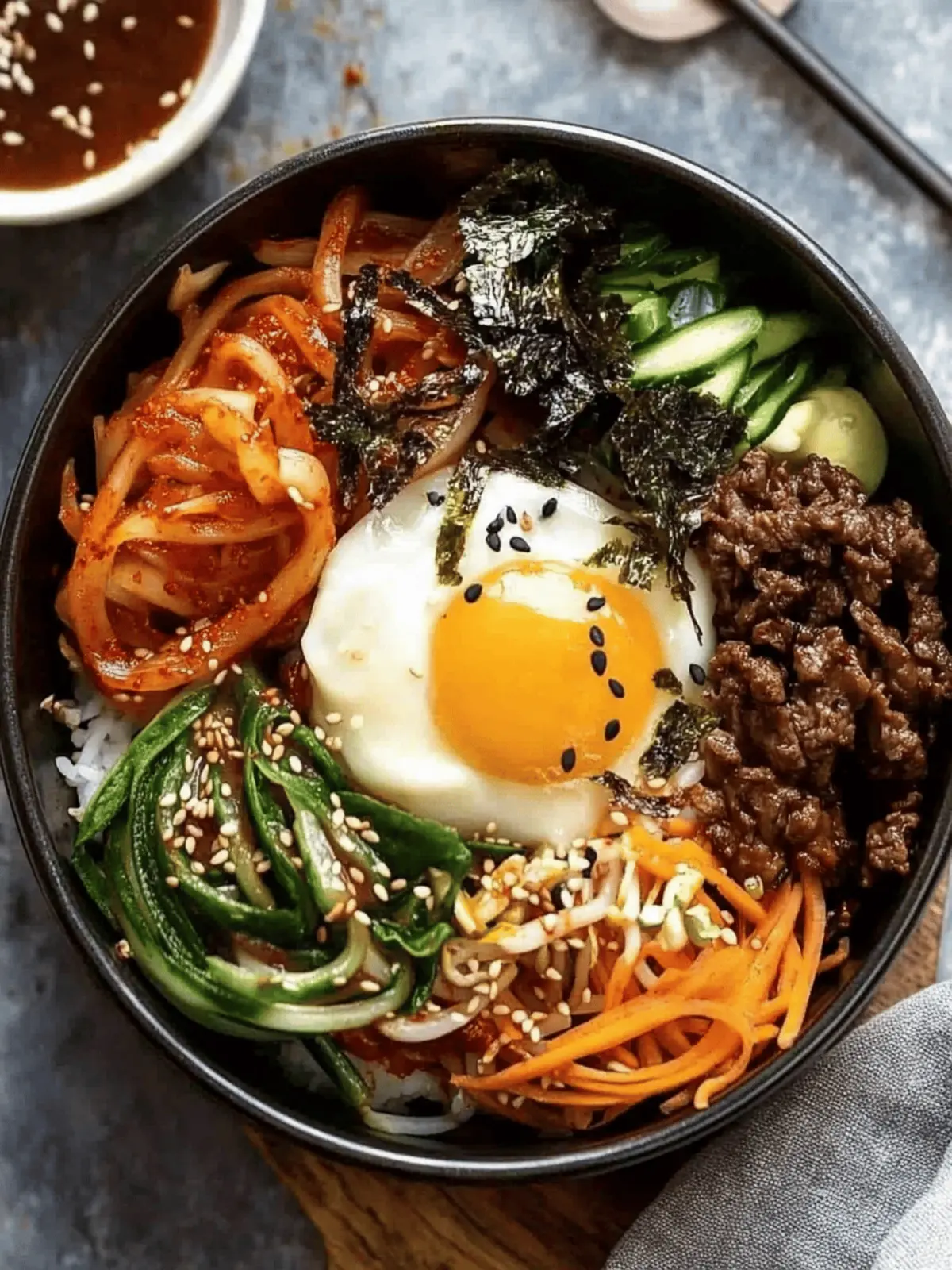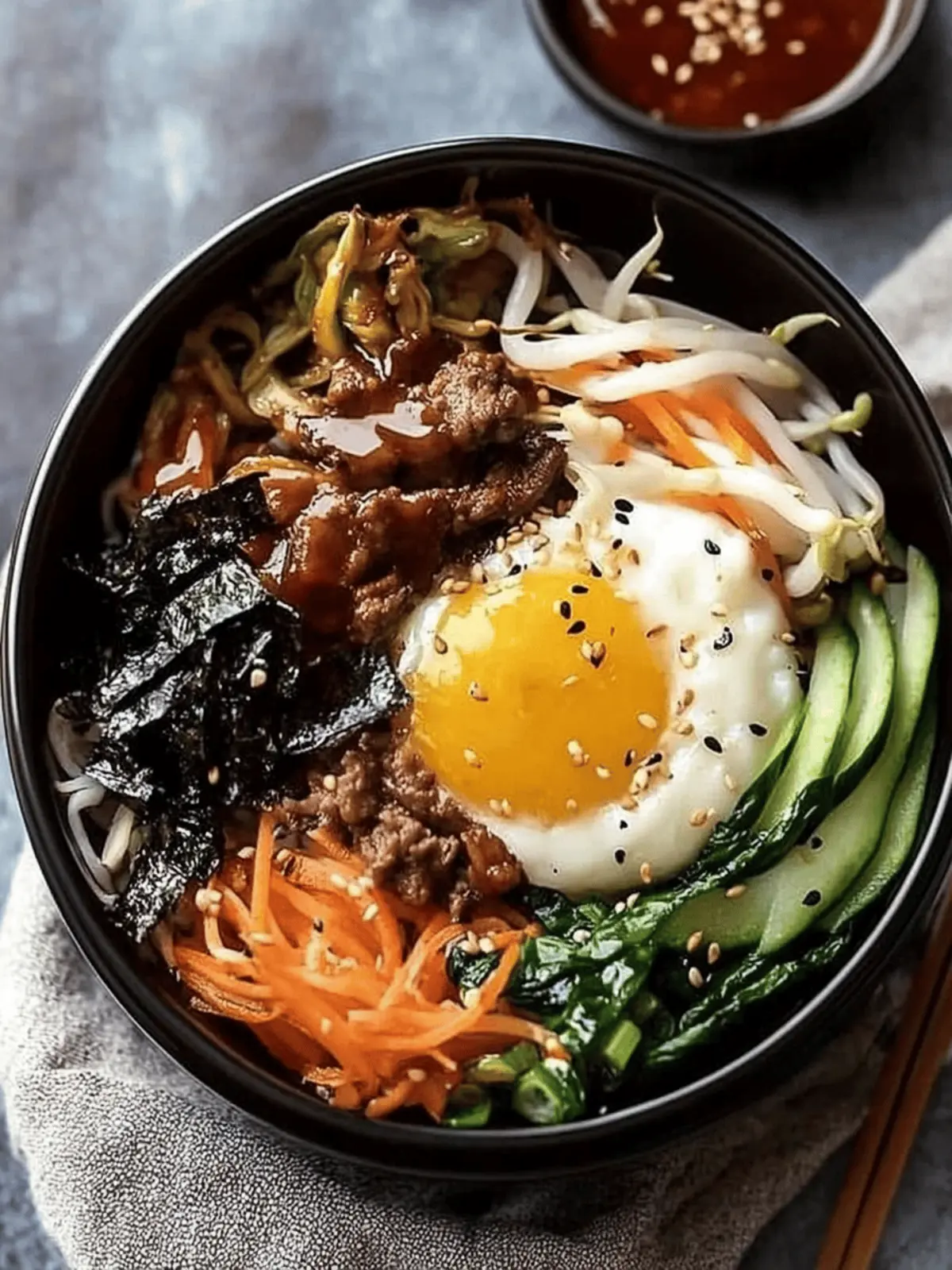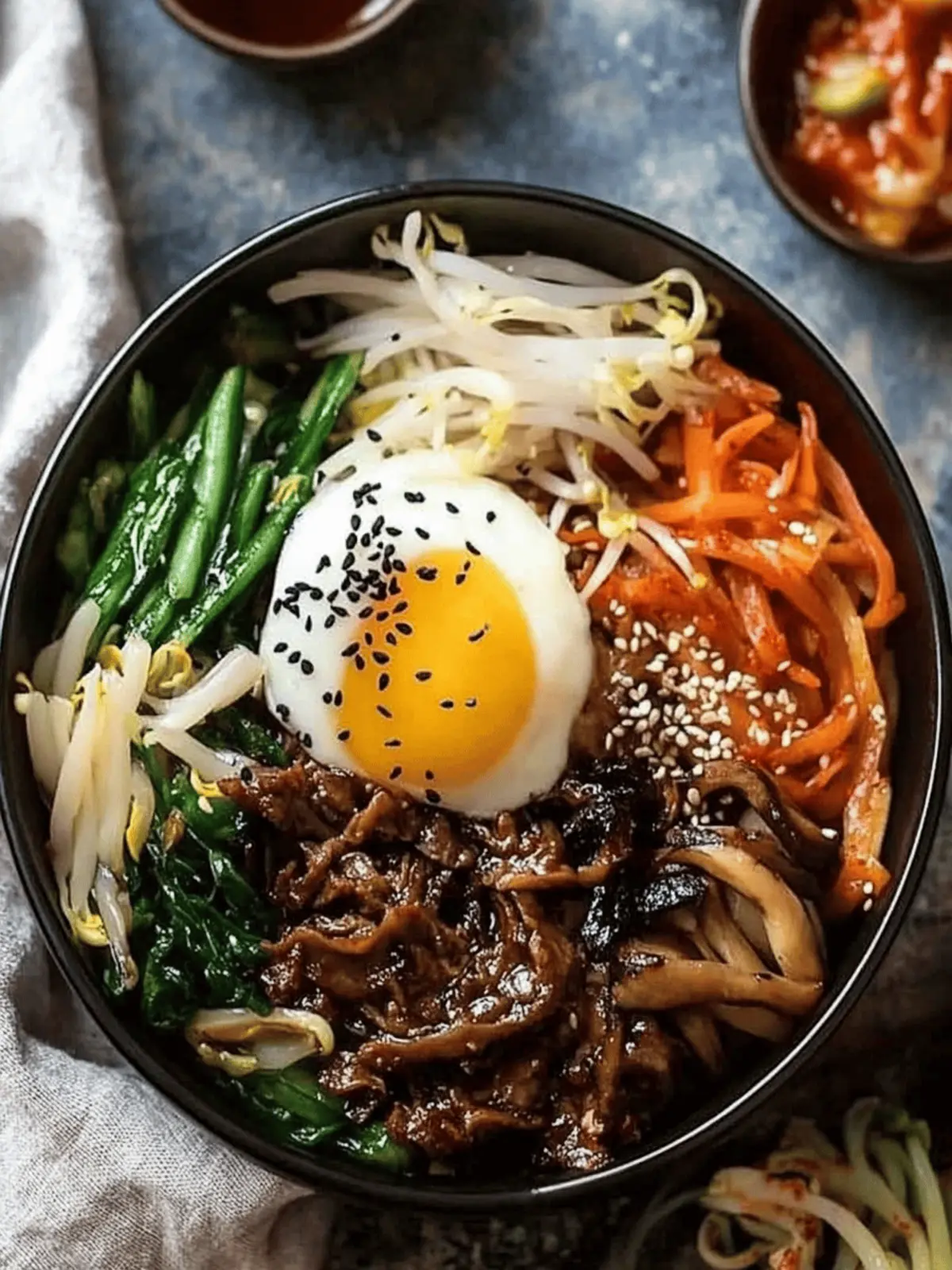There’s something truly enchanting about the way a simple bowl of rice can transform into a feast for the senses. As I stood in my kitchen, the colors of fresh vegetables and the sizzle of marinated beef all came together, reminding me why I love cooking. Enter Bibimbap a delightful Korean rice bowl that brings a vibrant medley of flavors and textures straight to your table.
This delightful dish is not just strikingly beautiful; it’s incredibly versatile, allowing you to swap in your favorite vegetables or proteins based on what’s hiding in your fridge. Whether you’re a seasoned home chef or just starting your culinary journey, this Bibimbap recipe promises an easy and delicious experience that will satisfy any craving for comfort food. So, let’s dive into the world of Bibimbap, where each bite tells a story and every ingredient has a role perfect for sharing with family or indulging on a cozy night in!
Why is Bibimbap the ultimate comfort food?
Versatile and Customizable: With a mix of fresh vegetables, proteins, and spices, this Bibimbap recipe allows you to create a meal that’s uniquely yours.
Bursting with Flavor: The combination of marinated beef, creamy egg, and spicy gochujang delivers a delicious punch in every bite.
Quick to Prepare: Ready in under 30 minutes, this dish gets you a wholesome meal fast, perfect for busy weeknights!
Colorful Presentation: The vibrant colors of the ingredients make for an Instagram-worthy meal that impresses family and friends.
Healthy Fusion: Packed with nutrients from fresh veggies and lean proteins, it’s a guilt-free indulgence that won’t compromise on taste.
No more boring takeout—dive into a bowl of sizzling warmth and delight with this easy Bibimbap recipe!
Bibimbap Recipe Ingredients
Start Your Flavor Adventure: Each ingredient plays a vital role in crafting this easy and delicious Korean comfort food!
For the Rice
• Short-Grain Rice – This sticky base holds everything together, providing a satisfying texture.
For the Beef
• Marinated Beef – Adds savory depth; marinate for at least 30 minutes for the best flavor punch.
For the Vegetables
• Carrots – Sweet and crunchy; they bring a delightful color contrast.
• Spinach – Offers nutrients and a fresh taste; use it lightly sautéed or blanched.
• Mushrooms – Earthy and hearty, they add wonderful umami to your bowl.
For the Egg
• Fried Egg – Creates a creamy topping; fry until the yolk is runny for extra richness.
For the Sauce
• Gochujang (Korean Chili Paste) – Essential for that authentic Bibimbap kick; adjust the amount for your desired spice level.
• Sesame Oil – Drizzle for a nutty finish, enhancing the overall flavor profile.
Gather these ingredients and get ready to enjoy a colorful and heartwarming Bibimbap that embodies the essence of Korean cuisine!
How to Make Bibimbap
- Prepare the Rice: Cook short-grain rice using a rice cooker or pot according to package instructions. Once done, fluff with a fork and set aside to keep warm.
- Sauté the Vegetables: Heat a little oil in a pan over medium heat. Sauté your chosen vegetables (like carrots, spinach, and mushrooms) until tender, about 5-7 minutes.
- Cook the Beef: In a hot skillet, add the marinated beef and stir-fry for 5-7 minutes until browned and cooked through.
- Fry the Egg: In a lightly oiled pan, fry the egg on low heat until the whites are set and the yolk is runny, which takes about 2.5-3.5 minutes.
- Assemble the Bibimbap: In a large bowl, layer a generous serving of warm rice, then top with sautéed vegetables, cooked beef, and the fried egg.
- Add Finishing Touches: Drizzle with sesame oil and gochujang, then mix everything together before digging in to savor the incredible flavors.
Optional: Garnish with sliced green onions for added freshness and color.
Exact quantities are listed in the recipe card below.
How to Store and Freeze Bibimbap
Fridge: Store each component of your Bibimbap in separate airtight containers for freshness, lasting up to 3 days. This keeps flavors vibrant and textures intact.
Freezer: If you want to save it for later, freeze the rice and cooked beef in airtight bags for up to 2 months. Avoid freezing the fried egg and fresh vegetables to maintain quality.
Reheating: For best results, reheat rice gently with a splash of water in the microwave to prevent drying out. Sauté vegetables and beef in a pan for a quick warm-up.
Assembling Later: If you’ve prepped everything, just combine at mealtime for a fresh Bibimbap experience without compromising flavor or texture!
Tips for the Best Bibimbap
• Ingredient Prep: Wash and chop vegetables ahead of time to streamline the cooking process and ensure everything is ready to go for your Bibimbap recipe.
• Sticky Rice: Using short-grain rice is essential for achieving that perfect sticky texture that holds all the ingredients together. Avoid long-grain rice for this dish.
• Egg Cooking: Fry your egg until the yolk is runny this adds richness to your Bibimbap, so monitor closely during the last moments of cooking.
• Store Leftovers Correctly: Keep each Bibimbap component in separate airtight containers to maintain freshness. Combine only when ready to eat for the best experience.
• Reheat with Care: If you have leftover rice, sprinkle a little water on it before microwaving to prevent it from drying out. Enjoy every flavorful bite!
What to Serve with Bibimbap?
There’s nothing like rounding out a delicious meal with complementary sides that enhance your dining experience.
- Refreshing Cucumber Salad: The crunch and coolness of cucumbers provide a perfect contrast to the warm rice bowl, brightening each bite.
- Korean Kimchi: This tangy and spicy fermented side adds layers of flavor that beautifully balance the richness of the Bibimbap.
- Savory Miso Soup: A warm bowl of miso soup brings a comforting umami flavor, keeping true to the wholesome theme of Korean cuisine.
- Steamed Dumplings: The soft texture of dumplings pairs wonderfully with Bibimbap, creating a delightful combination of flavors and textures on your plate.
- Sesame Spinach: This simple side dish, with its nutty undertones, complements the flavors of Bibimbap while adding an extra bite of greens.
- Sweet Potato Fries: Crispy on the outside and tender on the inside, they add a bit of sweetness that rounds out the meal’s rich flavors.
- Chilled Japchae: Sweet potato noodles stir-fried with vegetables offer a unique twist, presenting a delightful chewy element to enjoy alongside Bibimbap.
- Chilled Soju or Korean Beer: Pair your meal with these light drinks, which refresh the palate and enhance the overall dining experience.
Make Ahead Options
These Bibimbap bowls are a fantastic option for meal prep enthusiasts! You can prepare the rice and sauté the vegetables up to 3 days in advance, storing them in airtight containers in the refrigerator for maximum freshness. Marinate the beef for up to 24 hours beforehand to intensify the flavor. Keep each component separate until you’re ready to assemble your meal to maintain quality—this prevents the vegetables from wilting or the rice from becoming dry. When it’s time to enjoy your Bibimbap, simply reheat the rice and vegetables, cook a fresh fried egg, and assemble your bowl. This method ensures that your meal is just as delicious and satisfying, saving you time on busy weeknights!
Bibimbap Variations & Substitutions
Get ready to explore exciting twists that make this dish even more delightful and tailored to your palate!
- Vegetarian Delight: Swap out beef for firm tofu, marinated and sautéed for a satisfying protein alternative. It’s just as tasty and enjoyable!
- Seafood Twist: Replace beef with sautéed shrimp or pieces of fish for a delightful ocean-infused flavor that adds a fresh twist.
- Spicy Upgrade: Add extra gochujang or a dash of chili oil for those who crave an extra kick in every delectable bite.
- Mushroom Medley: Incorporate different types of mushrooms, like shiitake or portobello, for an earthy flavor boost that enhances the dish’s umami depth.
- Fruity Burst: Toss in some thin slices of apple or pear for a surprising sweetness that contrasts beautifully with the savory components.
- Whole Grain Base: Swap short-grain rice for quinoa or brown rice to add texture and nutritional value while still delivering a filling experience.
- Creamy Cashew Sauce: Drizzle with a homemade cashew sauce instead of gochujang for a milder, creamy flavor that pairs nicely with the fresh veggies.
- Noodle Alternative: For a unique twist, serve the Bibimbap over stir-fried noodles instead of rice for a fun fusion experience!
Feel free to mix and match these variations to create your perfect bowl of Bibimbap!
Bibimbap Recipe: Easy and Delicious Korean Comfort Food Recipe FAQs
What type of rice is best for Bibimbap?
For the best Bibimbap experience, you should use short-grain rice. Its sticky texture ensures that all the beautiful ingredients stay together. Long-grain rice doesn’t provide the same clinginess, which is crucial for achieving that hearty bite.
How do I store leftovers from my Bibimbap?
Absolutely! To keep your Bibimbap fresh, store each component separately in airtight containers. This method extends the freshness of the ingredients for up to 3 days in the fridge. Keep the rice, vegetables, beef, and fried egg stored separately, and only mix them together just before eating to maintain the best flavor and texture.
Can I freeze Bibimbap components?
Yes, you can! For long-term storage, freeze the cooked rice and marinated beef in airtight bags for up to 2 months. However, I recommend against freezing the fried egg and fresh vegetables, as they don’t reheat well and may lose their texture. When you’re ready to feast, simply thaw, reheat, and assemble your Bibimbap for a delicious meal!
What if my vegetables become soggy when reheated?
Very! If your vegetables tend to get soggy, try sautéing them just before adding them to the dish. When reheating, use a pan to quickly stir-fry them on medium heat until they are warmed through, which can help retain their crunch. This way, you’ll enjoy that delightful texture even when reheating leftovers!
Is Bibimbap suitable for people with dietary restrictions?
Absolutely! Bibimbap is incredibly versatile, making it easy to cater to various dietary needs. For vegetarian options, swap out the beef with tofu or tempeh. If there are allergy concerns, always check the labels on the gochujang and sesame oil to avoid any unwanted ingredients. It’s a meal that’s customizable to suit everyone at your table!
How do I ensure the egg is perfectly cooked in my Bibimbap?
The yolk is what brings this dish to life! To achieve a runny yolk, fry the egg on low heat and keep an eye on it—around 2.5 to 3.5 minutes should do the trick. If you’re unsure, you can even lid the pan for a minute to ensure the whites are set while keeping that gorgeous, rich yolk intact! Enjoy that wonderful creaminess as it melds with the other ingredients!

Bibimbap Recipe: Easy Korean Comfort Food for Flavor Lovers
Ingredients
Equipment
Method
- Cook short-grain rice using a rice cooker or pot according to package instructions. Once done, fluff with a fork and set aside to keep warm.
- Heat a little oil in a pan over medium heat. Sauté your chosen vegetables (like carrots, spinach, and mushrooms) until tender, about 5-7 minutes.
- In a hot skillet, add the marinated beef and stir-fry for 5-7 minutes until browned and cooked through.
- In a lightly oiled pan, fry the egg on low heat until the whites are set and the yolk is runny, about 2.5-3.5 minutes.
- In a large bowl, layer a generous serving of warm rice, then top with sautéed vegetables, cooked beef, and the fried egg.
- Drizzle with sesame oil and gochujang, then mix everything together before enjoying.








